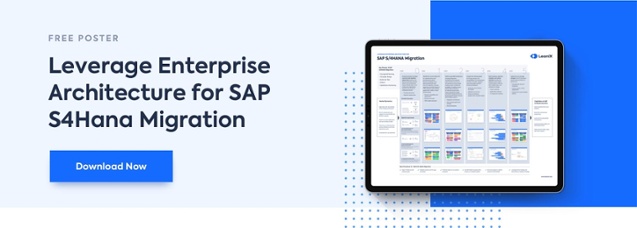
ERP transformation fails in up to 75% of cases. Let's consider how roadmapping your transformation in advance can mitigate the risks and make your upgrade to SAP S/4HANA a success.
Enterprise resource planning (ERP) transformation is complex and nuanced. Beginning an initiative without a comprehensive plan is a sure way to join the 75% of Gartner survey respondents who reported their ERP transformation had failed (ERP Implementation: To Avoid Project Failure, Assess the Impact of Change Before Starting Configuration).
In the first part of this series of articles, we looked at why ERP transformation is so crucial and how you can leverage the LeanIX enterprise architecture management (EAM) platform to get a better overview of your ERP system as the first step in your initiative.
For more information, download our free white paper:
In this article, however, we'll be moving along to consider how you can use that view of your ERP landscape to fully plan out your ERP transformation before you begin. This will dramatically improve your chances of success.
The key here is to begin with the overview of your current ERP system and how it connects to your business processes and physical touchpoints, as we explained before. Next, create a target state - a goal for how you want your ERP system to look like in an ideal world. Your roadmap is simply a line drawn between those two conditions.
The roadmap then becomes a project plan for a step-by-step roll-out of your new ERP system and your ongoing digital transformation. Let's look more closely at how you can put this together.
Plan And Track Your ERP Transformation
To begin with, you will want to make your current enterprise resource planning (ERP) state as visible to your organization as possible. As we discussed in the previous article in this series, a crucial step in ensuring the validity of the current state of your ERP system is displaying it in a digestible level of detail to all your stakeholders.
As Signavio explains in their white paper on ERP transformation:
"This step will be much easier with a software tool that allows for visibility and collaboration across departmental boundaries"
7-Step Guide To ERP Transformation, Signavio
This is where an enterprise architecture management (EAM) tool like the LeanIX EAM platform comes in. To find out more, book a demo:
Now that you've moved on to the roadmapping stage, it's time to make use of your visualized ERP snapshot once again. Send out more surveys and hold more consultations with your stakeholders to ask them to look at the snapshot again, but this time ask them about changes they'd like to see made to the ERP system and digital processes in general.
Application Rationalization In ERP Transformation
Also consider the results of the application rationalization initiative you carried out as part of the first step in your transformation that we detailed in the first part of this series. Following the Gartner TIME methodology, you will now have your applications categorized into four statuses:
- Tolerate - applications you plan to eliminate in the long term
- Invest - high-value applications you plan to invest in
- Migrate - applications you intend to replace or change hosting strategy
- Eliminate - applications you plan to eliminate in the short-term
Add this plan to your ERP transformation strategy. After all, the way your enterprise resource planning (ERP) system connects to your applications in the future will be important to your strategy and there's very little point in working on a strategy to migrate an app that you will soon eliminate.
ERP Transformation To SAP S/4HANA
Lastly, you'll need to consider your new enterprise resource planning (ERP) system itself. What will you need to change about your processes in order to accommodate transformation to SAP S/4HANA or whichever system you're upgrading to?
Ask yourself:
- What physical touchpoints does the new ERP system have?
- What hardware will be needed to support those touchpoints and host the platform?
- What software integrations does it require and what is it capable of?
- stakeholder wishes for future ERP capabilities
- your TIME quadrants for application rationalization
- the requirements of your new ERP system
Using these ambitions, you can build a picture of your ideal future ERP system state. This can be done directly within the SAP LeanIX platform, which will make your future state snapshot available to stakeholders to provide input and feedback.
Completing A Roadmap For ERP Transformation
Once approved by all the impacted departments in your organization, you can begin to use this to build your roadmap. Simply ask yourself what the requirements are to move from your current state snapshot to your future state snapshot:
- What resources will be required for the transformation?
- What talent will be needed to complete the transformation?
- In what order will the changes need to be made?
- What is a realistic timescale for each change you intend to make?
- Are there any dependencies between changes?
Putting all this together, you will be able to create a roadmap for your enterprise resource planning (ERP) transformation within the SAP LeanIX platform. This will be visible to all your stakeholders for their feedback and approval.
This is your time to experiment. Using the SAP LeanIX, you can make changes to your future state and explore how that changes your roadmap to find the best strategy.
SAP LeanIX, however, isn't project planning software. It will simply show you where you are, where you need to get to, and how you will get there. Mapping out tasks and owners will be up to your project management team.
Get A Snapshot Of Project Resource Demands
One of the key benefits of your roadmap is that it gives you a clear overview of the resources you will need to complete your transformation. This should include:
- Software and applications
- Talent and consultancy
- Internal person-hours
- Technical debt
- Data migration
Knowing how much resource is required will help to gain stakeholder buy-in on your enterprise resource planning (ERP) transformation. It will also confirm that your ERP transformation will achieve the highest value for the lowest expense.
Foster Collaboration For Your ERP Transformation
Stakeholder alignment is key for enterprise resource planning (ERP) transformation. As we explained in the previous part of this series, your ERP system is the central nervous system of your organization, so an ERP transformation will impact all your colleagues.
Not to mention, you will need to collaborate with all of the other parts of your business in order to identify all the impacts of an ERP transformation. Using the LeanIX EAM as a single source of truth where all your stakeholders can provide input and understand the roadmap for your transformation is the best way to encourage collaboration and participation in your ERP transformation.
In the next part of this series, we'll consider how you can actually go about your ERP transformation. We'll cover tips on how to stay on budget and schedule with your transformation as you navigate complexity.
In the meantime, to find out more about how LeanIX can support your ERP transformation, see our use case:


.png?width=140&height=107&name=BTMPlaybook-FI%20(1).png)

